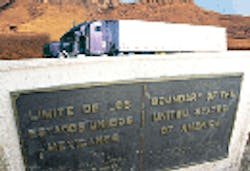Following through on a promise made by President Barack Obama in early 2009, the U.S. Department of Transportation (DOT) has made available a “concept document” that outlines parameters under which Mexican trucking companies could gain full operational authority within the U.S.
DOT described the document as a “starting point” for negotiations with Mexico to renew the cross-border program, which was ended in March 2009. At the time, Obama and Secretary of Transportation Ray LaHood promised a new proposal would be forthcoming.
The cross-border demonstration program was officially launched in 2007 by the Bush Administration to comply with terms of the North American Free Trade Agreement (NAFTA). Under that pilot program, Mexican carriers had to register their vehicles and up to 100 such carriers could operate at any given time inside the U.S. The actual number of carriers that participated was significantly less.
The new DOT proposal includes a five-step process for any Mexican carrier seeking to operate inside the U.S. There will be an application process followed by a vetting procedure that would require both the Dept. of Homeland Security and the Dept. of Justice to sign off on the carrier.
Initially, a limited number of carriers would be allowed into the program, DOT said, to allow for proper program oversight.
After completing the vetting process, each carrier would then go through a pre-authority safety audit (PASA) that would review safety management programs and driving records for participating drivers only. Also included in this process would be a vehicle inspection to ensure the trucks meet Federal Motor Vehicle Safety Standards (FMVSS) and EPA emissions standards.
Drivers would also be tested on their English language proficiency and knowledge of U.S. traffic laws.
The program would “document Mexican Commercial Driver’s License process to demonstrate comparability” and then the carrier would need to prove insurance coverage to FMCSA.
Once accepted into the program, DOT said, carriers would be monitored and, for an agreed upon timeframe between the U.S. and Mexico, each vehicle would be inspected by FMCSA each time it crosses the border heading north.
Each Mexican company would undergo a follow-up review and if acceptable, the company’s trucks would only face border inspections at the normal rate and inspections on U.S. roadways at the same rate as U.S. companies.
There will then be a second review, deemed a compliance review, and if the company receives a Satisfactory Safety Rating during this process, it would then be given full operating authority.
According to DOT, a formal proposal will be issued in the coming months and will be open to public comment.
However, interested parties pro and con are not waiting until then to declare their views on the proposal.
“Today’s news that the [Obama] administration is taking a first step toward resolving the long-running U.S.-Mexico trucking dispute is very welcome,” said Thomas Donohue, U.S. Chamber of Commerce president & CEO. “If we’re going to double exports within five years, we must hold on to export markets, such as Mexico, where American companies are already doing well.”
“I am deeply disappointed by this proposal,” Jim Hoffa, general president of the International Brotherhood of Temasters said. “Why would the DOT propose to threaten U.S. truck drivers’ and warehouse workers’ jobs when unemployment is so high? And why would we do it when drug cartel violence along the border is just getting worse?”
Hoffa also questioned DOT’s ability to monitor Mexican trucks to ensure roadways in the U.S. remain safe.
“We continue to have serious reservations about DOT’s ability to guarantee the safety of Mexican trucks,” he said. “Mexican trucks simply don’t meet the same standards as U.S. trucks – they don’t even have to have antilock brakes. Medical and physical standards for Mexican trucking firms are lower than for U.S. companies. And how can Mexico enforce highway safety laws when it can’t even control drug cartels?”
“It’s past time that we kept our word and complied with the promise we made to allow carefully inspected trucks to move across the border,” the U.S. Chamber’s Donohue remarked. “We will closely study the U.S. proposal and hope we can help implement a modern cross-border transportation system that provides certainty for trucking companies and shippers throughout North America.”
The U.S. Chamber claims that more than 25,000 U.S. jobs are at stake if a new cross-border program is not instituted.
Like the Teamsters, the Owner-Operator Independent Drivers Assn. (OOIDA) is not happy with the proposal, according to Todd Spencer, executive vp of the organization.
“With so much focus in Washington on creating jobs, it’s a bit shocking that the administration would pursue a program that can only rob U.S. drivers of their jobs,” said Spencer. “While we appreciate that the administration is proposing to allow Congress and the public to weigh in on a future trucking program with Mexico, they seem to be missing the main issue at hand. The onus is upon Mexico to raise their regulatory standards, not on the U.S. to lower ours to accommodate their trucking industry.”
After the initial cross-border program was ended by the U.S., Mexico retaliated by placing more than $2.4 billion worth of tariffs on U.S. goods heading to Mexico. The country then upped the ante even more to pressure the U.S. by adding another $2.5 billion in tariffs on 99 additional products, mostly agricultural in nature, in August 2010.
For more on the cross-border issue, click: Fleet Owner’s Special Report: Mexico: A one-way border.
